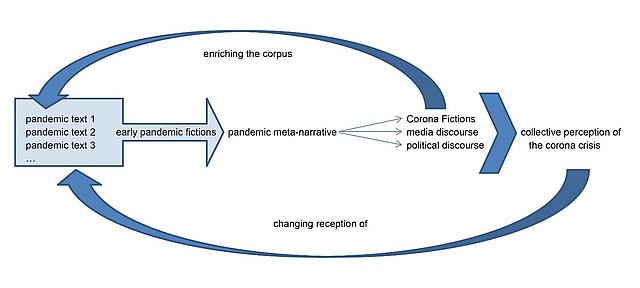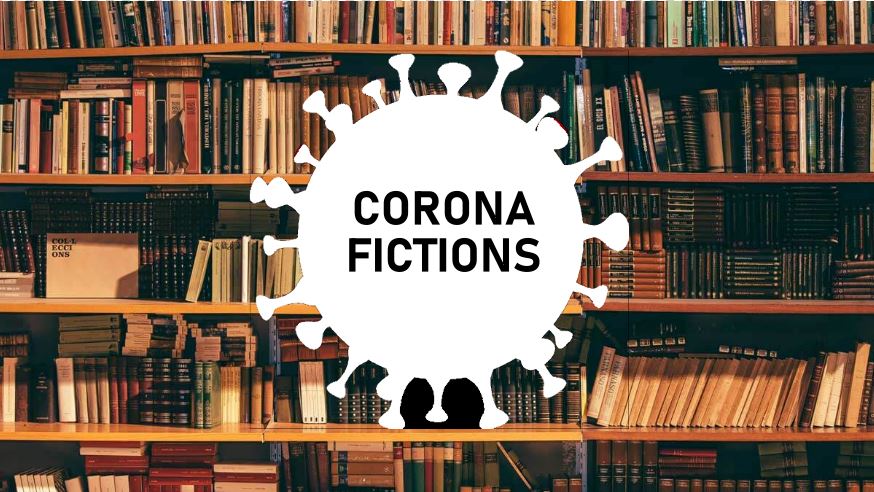Hypothesis

We argue that pandemic narratives in general have a great impact on both individual and collective world-making. They shape the perception of reality influenced by potentially traumatizing events, such as the WHO’s proclamation of the Covid-19 pandemic on March 11, 2020 (cf. Adhanom Ghebreyesus 2020), and its worldwide aftermaths. This assumption is based on Nünning’s (2013) reflections on the fact that narratives massively influence our perception of reality. Recent studies (cf. Scrivner 2020; Scrivner/Johnson/Kjeldgaard-Christiansen/Clasen 2020), have also shown that people who watch pandemic movies and fans of horror genres in general exhibited an increased resilience during the corona crisis. The guiding hypothesis of the project can therefore be resumed as follows:
Pandemic narratives are based on reactivated consistent structures creating constants over time and space. These structures or consistent characteristics circulate across media, thus ‘spreading’ through transmedia storytelling (Jenkins 2007), hereby forming an overarching meta-narrative. Most of the narrative elements contained in pandemic fictions (e.g. outbreak, carrier, post-pandemic narrative) seize aspects of this meta-narrative and, in turn, transfer their genre characteristics to the content. Despite the corona crisis reactivating consistent structures of pandemic fictions, it is important to be aware of the fact that genre formations such as those of the chronicle, film, etc. in each case affect the concrete characteristics of the pandemic discourse differently.
This broad scope is essential to our interdisciplinary and transmedia approach[1] as the human brain does not process images and words equally. While the neocortex (reason) deals with spoken and written languages, the reptilian brain (strong emotions and instincts) handles images differently; therefore, allowing media to function on an emotional level (cf. Media Literacy Project 2012). In order to generate emotional tension, a ‘contract’ between a film or series and the audience – similar to Lejeune’s ‘autobiographical pact’ (1975) – is needed. In filmic contexts, Zag (cf. 2010, 14) calls these built up emotions the ‘human factor’, since people’s conception of the future is arguably formed on generic expectations. For example, while the dystopian view predicts the corona crisis to lead into a catastrophe, the dystopian narrative explains why citizens deliberately support governmental decisions on the economic shutdown, why they stay indoors, and why they accept the infringement of fundamental rights. By overcoming the ‘first wave’, however, it becomes obvious how leaving this dystopian frame generates other generic expectations. One strong emotion, the fear of the virus, is replaced by another: the equally dystopian fear of authoritarian regimes and, once again, generic expectations play a decisive role.
In this regard, the way we perceive information and entertainment has changed greatly over the course of the last two decades. With the emergence of social media and numerous streaming platforms for audiovisual content (Facebook 2004, YouTube 2005, Twitter 2006), or more generally speaking ‘quick media’ (cf. Friedman/Schultermandl 2016, 4), the pace and multi-faceted formats have transformed consumer behaviour as well. Similarly to the spread of the coronavirus, news ‘goes viral’, spreading almost in a ‘pandemic’ manner, crossing language barriers, cultural and national borders alike. Since languages can be considered a ‘representational system’ (cf. Hall 1997, 1), meaning is given to concepts/objects by people themselves. According to Chew and Eysenbach (2010, 1), meaning can be constructed when e.g. tweets are “used for real-time content analysis and knowledge translation research, allowing health authorities to respond to public concerns.” However, quick media not only function as immediate news sources but also encourage ‘participatory culture’ (Jenkins et al. 2016), meaning that individuals are able to participate in a transnational, transcultural conversation on a current situation.
Today, as narratives are often being created by ‘community involvement’ (cf. Jenkins 2009: xiii) throughout the digital world, spreading across different media formats and creating hybridity by merging video, image, text, and audio content with mutual references (cf. Nünning/Rupp 2012, 15), ‘transmedia storytelling’ (cf. Jenkins 2007) encourages not only a way of constructing content but also becomes a multi-modal approach to analyze the current Corona Fictions. ‘Transmedia storytelling’ creates a common meta-narrative, since the participants of this communicative context may function as producers and receivers of stories alike (cf. Nünning/Rupp 2012, 15): “Jenkins’s understanding of texts operating within transmedia, or as he calls it ‘transmedia storytelling’, does not describe simultaneously narrated phenomena of the same kind but rather narrates parts of one single, bigger story across different media (with transmedia-specific storytelling strategies)” (Obermayr 2020, 102f.).
In the graph of the ‘pandemic circuit’ (see above), we illustrate this specific dynamic of the hermeneutic process of the pandemic meta-narrative between (early) pandemic fictions and Corona Fictions as well as media and political discourse (related to SARS-CoV-2 pandemic) which in turn change the reception of previous pandemic texts.
Historical pandemic key texts can be seen as part of a pandemic fiction, which in itself reproduces the pandemic meta-narrative it simultaneously creates. Today, the consistent structures of the pandemic meta-narrative highly influence aesthetic production of Corona Fictions as well as the political and media discourse. As a global historical event, the corona crisis reactivates the pandemic meta-narrative, thereby merging it with today’s technological achievements and the new media landscape. All these elements contribute to the collective perception of the corona crisis building the basis for a changing reception of the early pandemic fictions, simultaneously being enriched by novel Corona Fictions. All this causes a significant modification of the pandemic meta-narrative.
-----
[1] The ‘transmedia approach’ is based on Jenkins’ (2007) understanding of ‘transmedia storytelling’; thus, referring to a process of storytelling that distributes fictional elements across various media, serving one common meta-narrative while creating a coordinated entertainment experience. In this research, pandemic fiction, however, does not necessarily need to be coordinated in order to produce or experience it, yet generates a transcultural pandemic meta-narrative across different media and subgenres. Within the pandemic meta-narrative, on the other hand, Wolf’s (2002) definition of transmediality (‘Transmedialität’, with reference to Rajewsky 2002) is useful when applied to investigate the common narrative structures of pandemic fiction – regardless of the medium or genre –, as Wolf’s transmediality concept forms a subcategory of ‘overlapping’ (‘werkübergreifender’) intermediality.
